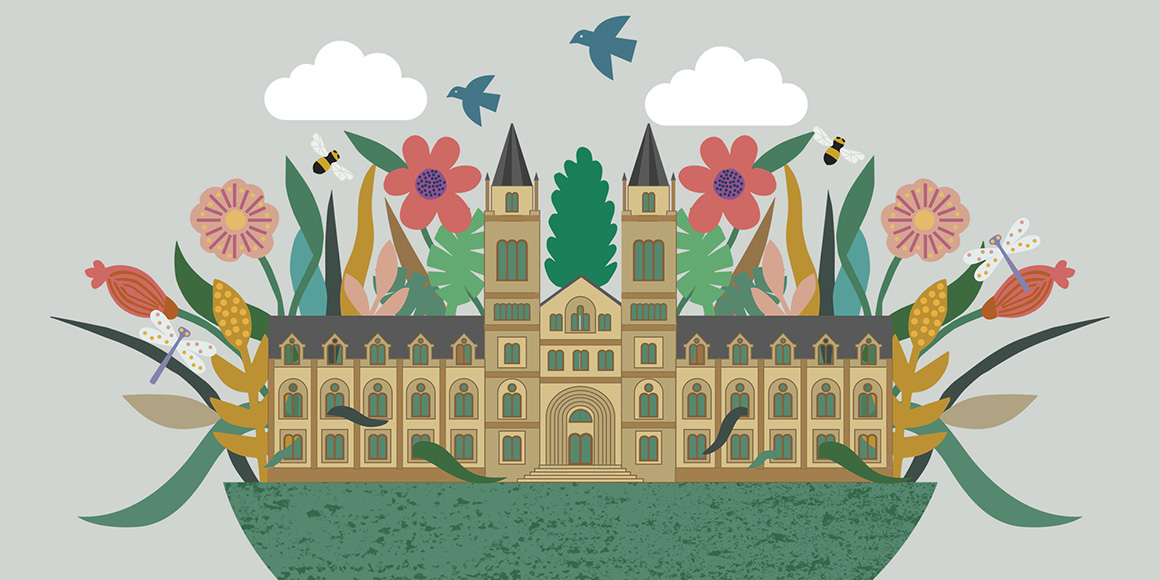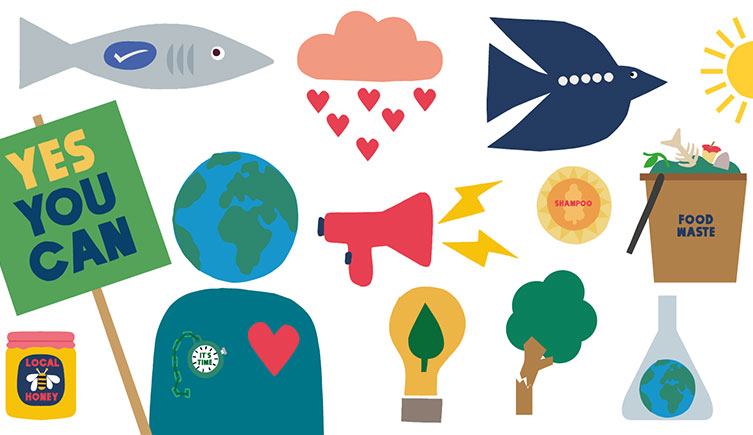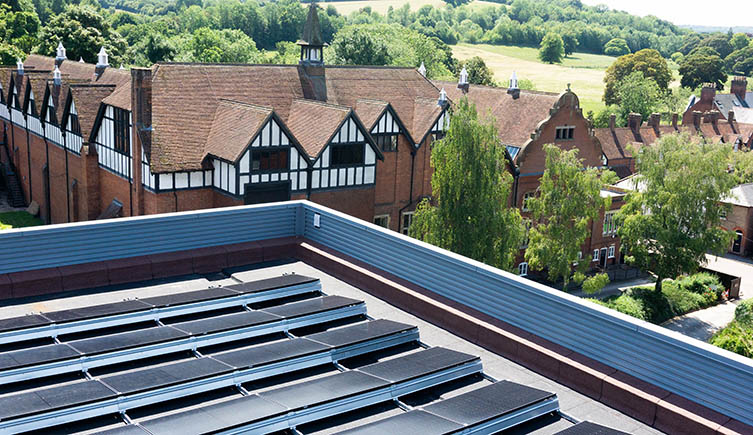Our scientific work
Our expertise in taxonomy, systematics and mineralogy is driving research projects aimed at securing the future of our food, health and natural materials.

As advocates for the planet, we try to think sustainably when making decisions and to operate in a way that’s kind to the environment.
We aren’t perfect, but we’re looking at ways we can reduce our carbon emissions and energy consumption, reuse and repurpose technology and encourage everyone to refill and recycle.
Read our environmental policy and take a look at our Sustainable by Nature Plan animation.
Our expertise in taxonomy, systematics and mineralogy is driving research projects aimed at securing the future of our food, health and natural materials.
Greenhouse gases are doing serious damage, so we want to limit and reduce the amount released into the atmosphere through our operations. The UK Government has asked everyone to reach net zero by 2050, but we’re aiming to get there by 2035.
It’s going to be complicated because we care for one of the most important natural history collections in the world, which needs specific conditions to maintain it and keep it safe. Nevertheless, we’ve set ourselves targets to help drive down our emissions as much as possible.
Our plan is to switch to greener technologies and prioritise energy efficiency and sustainable design.
Some parts of our work will always generate a small amount of carbon dioxide, no matter how energy efficient we become. Once we’ve done everything we can to tackle our emissions, we’ll explore carbon-offsetting schemes to achieve true net zero, but these will be a last resort.
We’ll always need energy, so we want to reduce how much we use and source it sustainably.
Solar panels were installed in 2020 at our Tring site, suppling enough energy to power the Ornithology Building. In 2022 we also installed a small solar array at our South Kensington site on the roof of our Palaeontology Building.
At South Kensington, most of our electricity comes from an onsite trigeneration energy centre. Although it burns natural gas, it combines cooling, heating and power to reduce waste and is the most efficient way for us to manage our energy needs at the moment. However, we’re looking into how we can decarbonise this energy centre by 2035. Works so far have included equipment upgrades and the introduction of heat pumps, as well as a range of Energy Conservation Measures that’ll help us gain tighter control and management of the energy consumption across our South Kensington site.
Of the electricity we import from the grid, 20% of it is under a Power Purchase Agreement (PPA) supplied by wind farms. As well as this, the supply at both our Tring and Wandsworth sites are backed by Renewable Energy Guarantees of Origin (REGOs), which certify that the equivalent volume of electricity is generated from renewable sources.
To help achieve our energy saving targets, we’ve recruited an Energy Manager and have committed to reducing energy intensity by 40% by 2030. We’ll do this by making existing systems more efficient and building energy efficiency into all new projects.
Our staff only travel when it’s necessary because we know that planes and cars produce greenhouse gases.
Sometimes our staff have to travel on planes to transport specimens safely, collaborate with partners effectively or study fragile ecosystems in detail. However, we’re working to reduce our reliance on flights and have introduced a new travel policy that prevents our staff from taking internal flights within the UK (except for reasonable adjustments and exceptions) and business-class flights.
Our vehicle fleet is small but we plan on moving to all electric vehicles by 2027 in line with the Green Government Commitments.

Small changes can make a big difference. Find out how you can help the planet.
Carbon emissions aren’t everything. Pollution and overconsumption are two big threats to nature.
Our scientists are at the forefront of research into the harmful effects of plastic and chemical pollution. Even on our doorstep, we know that more than a quarter of fish in the Thames Estuary are eating plastic.
That’s why we’re trying to generate as little waste as possible and working to maximise reuse and recycling.
We’d aimed to increase our average operational recycling rate to at least 60% but despite an overall reduction in the amount of waste we produce, we’ve fallen short of our target, remaining in line with the national average.
We have been producing less waste, with volumes remaining below pre-pandemic levels.
We want to push ourselves to do better. To help us plan how to get there, we’re going to:

A drawer of flies in our collections. We use specimens like these to research the impacts of climate change and biodiversity loss.
Water is one of Earth’s most precious resources.
The United Nations (UN) estimates that water scarcity affects more than 40% of the global population, a figure that’s projected to rise even further. By 2030 the UN wants every country to begin using water more efficiently, to make sure there’s enough clean water to go round.
We’ve gradually been undertaking measures to reduce our water consumption, such as fitting dual-flush cisterns that reduce the volume of water used to flush toilets and installing sensor-controlled or push-button taps, which can reduce water consumption.
By 2026 we’re aiming to reduce our water consumption by 20% against a 2017/2018 baseline, by:
Money is powerful, so we want to make our money work for good.
We investigated opportunities to move our investments into a sustainable fund in 2020/2021 and in May 2022 we transferred to a Charities Ethical Investment Fund that’s managed in accordance with the UK Stewardship Code.
All new starters have their pension contributions automatically invested in a new default investment strategy, which invests responsibly and aims to help to contribute to a better future.
Many of our goals rely on cleaning up our supply chains. We want all our suppliers to join us in working in a way that’s kind to nature. We have several procurement policies and supporting documents that embed sustainability into our procurement process.
Carbon emissions come from all sorts of places, including our own buildings and the manufacture of the goods we buy.
Emissions are split into three scopes. Scopes 1 and 2 cover the emissions resulting from energy use in our buildings. We’re tackling these right away. Scope 3 covers everything else, including the procurement of goods and services, and is estimated to be twice as much as our Scope 1 and 2 carbon emissions.
We have limited control over Scope 3 emissions and their calculation can be complex, making them more difficult to tackle. For that reason, they’re not currently included in our net zero target, although we’re committed to encouraging advocacy for the planet within our supply chain, monitoring the emissions of our purchased goods and services and reducing the impact of our purchases.
Find out about what our retail teams and catering providers are doing too.
Our future plans include:
All our new projects will have sustainability at their heart.

The Natural History Museum at Tring is a unique place, home to internationally important zoological and ornithological collections.
As part of our commitment to embed sustainability in all areas of our work, we’ve made our Ornithological Building more self-sustaining by installing solar panels and improving the thermal performance with better insulation.
Throughout the project, which started in the summer of 2019, we tried to work in an environmentally and ethically sustainable way. We ensured an environmentally responsible design and recycled and reused materials wherever possible. We’re particularly proud that from September 2019 to March 2020, 95% of the construction waste produced was sent for recycling, resulting in 196 tonnes of material being diverted from landfill.
During 2020, we installed 318 solar panels, providing a total system capacity of 88kWp, capable of generating up to 75,835kWh a year - enough to meet the entire building’s annual electricity needs. This saves more than 21 tonnes of carbon dioxide emissions per year, which is equivalent to planting 10,514 trees, and also potentially saves us £9,100 per year in electricity bills.
Our ambition is to become a leader in sustainable retail. This means looking at sustainability in the round, so we’re working with our suppliers to look for solutions to challenges such as eliminating excess packaging and single-use plastics, sourcing more sustainable materials and using more sustainable manufacturing processes.
Here are some of the things we’ve changed in our shops so far:
Our retail and warehouse teams are also:
With such a large and varied product range, we recognise that we have a long way to go and we’re working hard to find the most sustainable solutions.
Purchases help us to care for our collection of more than 80 million specimens as well as support our 300 scientists, who are studying the natural world.
The food we eat can have a big impact on nature. We want to ensure everyone who visits us has a range of nutritious, sustainable food options to choose from.
We’re working with our catering partner Benugo to ensure that produce sold in our cafes and restaurants are sourced responsibly with as little environmental impact as possible. Here’s some of the work they’re doing to help advocate for the planet:
Grab & go and bakery items have a carbon count displayed, allowing customers to see the impact of their food to help inform decision making.
Plant-based milk alternatives are free of charge to encourage more frequent use.
Hot drinks are offered at a discounted price to discourage disposable cup use.
Sandwich packaging contains cellulose. Cellulose is a certified bioplastic, made from a plant-based polymer derived from cotton or wood pulp.
Coffee is 100% Rainforest Alliance certified – allowing Benugo to trade fairly with local farmers.
Scoop serve ice cream is made by B-Corp registered, family-owned businesses with milk sourced from UK dairies and with full farm to cone/tub traceability.
Nearly 100% of fresh eggs used are UK RSPCA Assured free-range.
Seafood is responsibly sourced and certified to independent environmental standards scheme.
Every bottle of Life Water sold helps fund clean water projects. To date, Benugo have helped fun 65 projects, providing 52,127 people with access to clean water.
Benugo’s chocolate partner, Tony’s Chocolonely, are focused on changing the chocolate industry by making 100% slave-free the norm.
Free tap water is available at all of Benugo’s outlets onsite plus there are now three bottle filling stations onsite at South Kensington in addition to other water fountains.
To help you make an informed choice, the carbon labelling on food purchased from the fridges in our cafes and restaurants shows the impact your food choices have on the environment. Even the smallest change to eating habits over time can help to save the planet.
A: The most climate-friendly choice available
B: Still a great option for the planet
C: Good sustainable effort
D: A less environmentally friendly option, best enjoyed in moderation
E: Least environmentally friendly option
Benugo is committed to being as sustainable as they possibly can across all aspects of their business, reducing their impact on climate and nature. They’re striving to make better choices in everything they do and are constantly updating their policies in line with this.
In 2023 they launched their ESG strategy, Second Nature. Underpinned by the United Nations Sustainable Development Goals, Second Nature is a roadmap of actions to successfully manage environmental and social impacts. Benugo’s goal is to significantly reduce carbon emissions to become carbon net zero for all emission scopes by 2040.
We won’t reach our goals unless we keep an eye on how we’re getting on.
We want to keep setting ourselves new targets and hope our Sustainable by Nature Plan will help us operate in a greener manner than ever before.
Information on our performance can be found within our annual accounts.